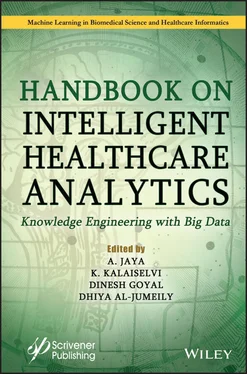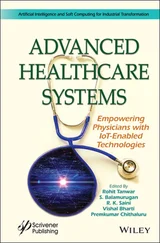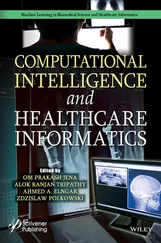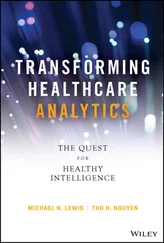Handbook on Intelligent Healthcare Analytics
Здесь есть возможность читать онлайн «Handbook on Intelligent Healthcare Analytics» — ознакомительный отрывок электронной книги совершенно бесплатно, а после прочтения отрывка купить полную версию. В некоторых случаях можно слушать аудио, скачать через торрент в формате fb2 и присутствует краткое содержание. Жанр: unrecognised, на английском языке. Описание произведения, (предисловие) а так же отзывы посетителей доступны на портале библиотеки ЛибКат.
- Название:Handbook on Intelligent Healthcare Analytics
- Автор:
- Жанр:
- Год:неизвестен
- ISBN:нет данных
- Рейтинг книги:4 / 5. Голосов: 1
-
Избранное:Добавить в избранное
- Отзывы:
-
Ваша оценка:
- 80
- 1
- 2
- 3
- 4
- 5
Handbook on Intelligent Healthcare Analytics: краткое содержание, описание и аннотация
Предлагаем к чтению аннотацию, описание, краткое содержание или предисловие (зависит от того, что написал сам автор книги «Handbook on Intelligent Healthcare Analytics»). Если вы не нашли необходимую информацию о книге — напишите в комментариях, мы постараемся отыскать её.
The book explores the various recent tools and techniques used for deriving knowledge from healthcare data analytics for researchers and practitioners. A Handbook on Intelligent Healthcare Analytics
Handbook on Intelligent Healthcare Analytics — читать онлайн ознакомительный отрывок
Ниже представлен текст книги, разбитый по страницам. Система сохранения места последней прочитанной страницы, позволяет с удобством читать онлайн бесплатно книгу «Handbook on Intelligent Healthcare Analytics», без необходимости каждый раз заново искать на чём Вы остановились. Поставьте закладку, и сможете в любой момент перейти на страницу, на которой закончили чтение.
Интервал:
Закладка:
One is the principle of “simulated ringing” that allows atoms to form large crystals at an energy stage, at a minimum, given the differences present on the physical search pathway. The other approach is the ringing for steel and other metals. The search algorithm involves a way of randomly extracting inputs from neighboring designs and merge them according to a given set of laws as applied to the optimization issue. The key task of the virtual anneal is to have a small but not nil chance of flipping from an improved to a lower configuration. This makes it possible to break the local minimum trap at the cost of temporary design inferiority and, in the long run, pays off by going onto a new quest route that can optimize the probability of achieving an optimum overall.
The “particle swarm optimization” envisages designs in production rooms as a swarm of entities (the swarm of bees was inspired). In line with simple mathematical formulae, the swarm is moved into the design space to draw the position and velocity of all particles in the swarm to incorporate local and global information.
1.7.8 Closing Remarks for GA
The method class referred to in this section is still being created, based on its simplicity and compatibility with parallel technology. The manufacturing is available for the effort to produce innovative GA models. Changes may be made to allow the number of design points in the next generation to vary adaptively; control the distribution of these points to get them closer together to bring them closer to the points that have become the healthiest in the previous generation; and parent three-fold rather than parent peers, or, ultimately, a group of parents to produce in children.
1.8 Artificial Neural Networks
Let us switch now to artificial neural network (ANN) for memory. Again, it will have an overview of how these works are done; let the reader study alternative in-depth perspectives, and propose Raul Rojas’ excellent text (1996). The section uses one aspect of a network and learning method that explains how business application vendors use a network, other network types, and learning processes. It is defined as having thousands of neurons, each of which is associated with more than a thousand other neurons in a rather simplified human brain model. Each neuron receives an electrical signal and transmits it to other brain network neurons. The neuron receives a signal from its associated neurons, and does not transmit the signal to other neurons immediately but waits until the concentration of the signal energy reaches level. In general, the brain learns by changing the amount of these connections and the signal thresholds.
ANN is constructed along identical lines except that node collections execute the location of neurons connected in the network, where a three-layer network is shown for ease. It has several layers defined as the input, hidden layers, and output of the neurons forming the interconnection network. The input neurons are the first information to deal with the problem, and the results and the solutions are in the output neurons. The hidden layer is an input and output layer network link. The diagram shows only one hidden layer, and we adhere for simplicity to one layer in this section, while there may be several such layers in some implementations.
The arrows in the image show the link between the neurons input n, the k hidden neurons, and the neurons in output m. Wisdom is seen as being fed on the left to right and is regarded as a feeding process. We undergo a back-breeding process in later portions. The way the network functions by its neurons has two major characteristics:
Neurons receive feedback from other neurons, however, the neuron also “flies” while the added neuron knowledge is of vital importance (a firing threshold). Information passing from one neuron to another is weighed by a variable that does not have a value affected by data within either neuron. The network is used to efficiently define alternatives to the issue by manipulating weighting variables.
1.9 Conclusion
One approach is to look for assistance using KBE approaches in solving the previous problem. KBE spans a wide range of engineering technologies and has tools that can capture and reuse the product and process knowledge to deliver individual users’ or MDO environment details and data. A good connection between rule-based reasoning, object-oriented modeling, and geometric modeling inside the KBE frame makes certain measures in the MDO process easy to grab and automate. As seen in this section, the MDO approach includes direct cooperation between some testing, optimization, and other modules and codes that work along with several variables of nature for the enhanced product. Capturing and reusing knowledge facilities will help to deliver sustainable parametric models by adapting the data to the various discipline data models and allow adjustments to flow across them. A major benefit from this capability allows the integration of homogeneous sets across a range of simulation tools, such that data and concept information can be transmitted smoothly from low- to high-trust research models as the design progresses over time. It helps to integrate internally and acquired technical capabilities into the MDO environment and helps them operate in parallel with the evolution of data and architecture expertise and the acquisition of increasingly complicated data structures combined with dynamic data comfort.
References
1. Chan, P.K.M., A New Methodology for the Development of Simulation Workflows. Moving Beyond MOKA, Master of Science thesis, TU Delft, Delft, 2013.
2. Cooper, D.J. and Smith, D.F., A Timely Knowledge-Based Engineering Platform for Collaborative Engineering and Multidisciplinary Optimization of Robust Affordable Systems. International Lisp Conference 2005 , Stanford University, Stanford, 2005.
3. Cottrell, J.A., Hughes, T.J.R., Basilevs, Y., Isogeometric Analysis: Towards Integration of CAD and FEA , John Wiley & Sons Inc, Chichester, 2009.
4. Graham, P., ANSI Common Lisp, Englewood Cliffs, NJ, Prentice Hall, 107, 384–389, 1995.
5. La Rocca, G., Knowledge Based Engineering: Between AI and CAD. Review of a Language Based Technology to Support Engineering Design. Adv. Eng. Inform ., 26 , 2, 159–179, 2012.
6. Lovett, J., Ingram, A., Bancroft, C.N., Knowledge Based Engineering for SMEs: A Methodology. J. Mater. Process. Technol ., 107 , 384–389, 2000.
7. Mcgoey, P. J., A Hitch-hikers Guide to: Knowledge-Based Engineering in Aerospace (& other Industries). INCOSE Enchantment Chapter, 2011. Available at: http://www.incose.org/. 1, 117–121.
8. Milton, N., Knowledge Technologies , Polimetrica, Monza, 2008.
1 *Corresponding author: d.karthi666@gmail.com
2 †Corresponding author: kalairaghu.scs@velsuniv.ac.in
2
A Framework for Big Data Knowledge Engineering
Devi T.1* and Ramachandran A.2
1Department of Computer Science & Engineering, Saveetha School of Engineering, Saveetha Institute of Medical and Technical Sciences, Saveetha University, Chennai, India
2Department of Computer Science & Engineering, B.S. Abdur Rahman Crescent Institute of Science and Technology, Vandalur, Chennai, India
Abstract
Analytics and analysis from a massive database using various approaches and techniques are experimented, and ongoing research brings its main focus toward the domain such as big data. Economic growth and technological growth combined with its data production are also highlighted in big data approaches. Data are analyzed from social media, online stock markets, healthcare data, etc., which can be collaborated with artificial intelligence by developing the automated learning algorithms and development in cloud computing as well. Data can be either discrete or continuous, which are independent of the various processes for understanding the decision-making that relies on knowledge engineering. The proposed work converges in transforming the observed sequential data analysis from weather forecasting dataset. These systems can perform the cognitive task in improving the performance along with integrity of data using the enhanced framework. The prediction of natural disasters is a challenge for customers accessing forecast data, since fluctuations in data occur frequently, which fail to update the localization, that are identified as sensor latitude and longitude that are updated as a sequence on regular intervals from various directions. These four hidden states are the features that differentiate the probability of distributions for calculating the best cognitive tasks. Improved Bayesian Hidden Markov Frameworks (IBHMFs) have been proposed to identify the exact flow of state and detect the high congestion, which leads to earthquakes, tremor, etc. As the data from the analysis are unsupervised and features are converted to discrete and sequential data (independent variables), IBHMF can utilize in increasing the performance and produce the accuracy results in state estimation.
Читать дальшеИнтервал:
Закладка:
Похожие книги на «Handbook on Intelligent Healthcare Analytics»
Представляем Вашему вниманию похожие книги на «Handbook on Intelligent Healthcare Analytics» списком для выбора. Мы отобрали схожую по названию и смыслу литературу в надежде предоставить читателям больше вариантов отыскать новые, интересные, ещё непрочитанные произведения.
Обсуждение, отзывы о книге «Handbook on Intelligent Healthcare Analytics» и просто собственные мнения читателей. Оставьте ваши комментарии, напишите, что Вы думаете о произведении, его смысле или главных героях. Укажите что конкретно понравилось, а что нет, и почему Вы так считаете.












